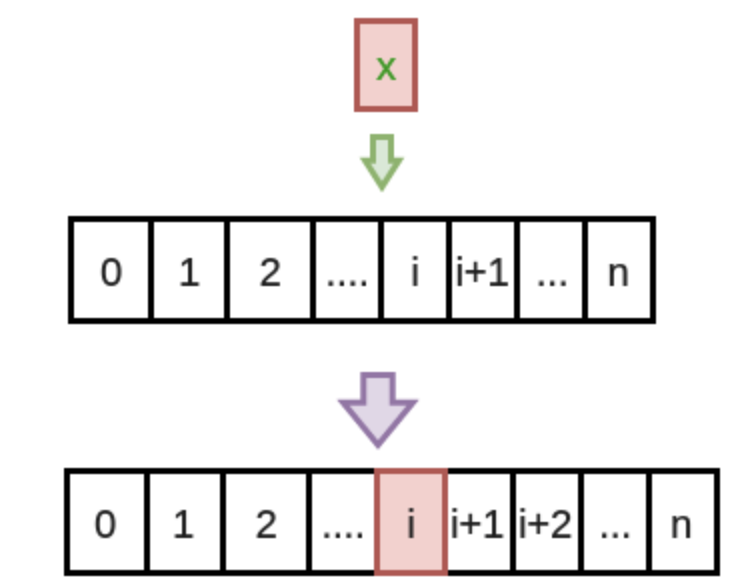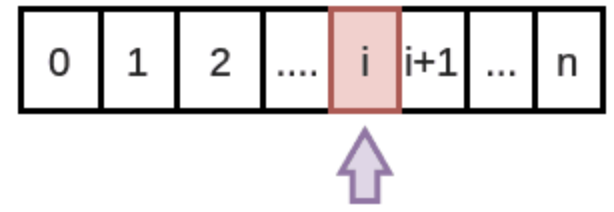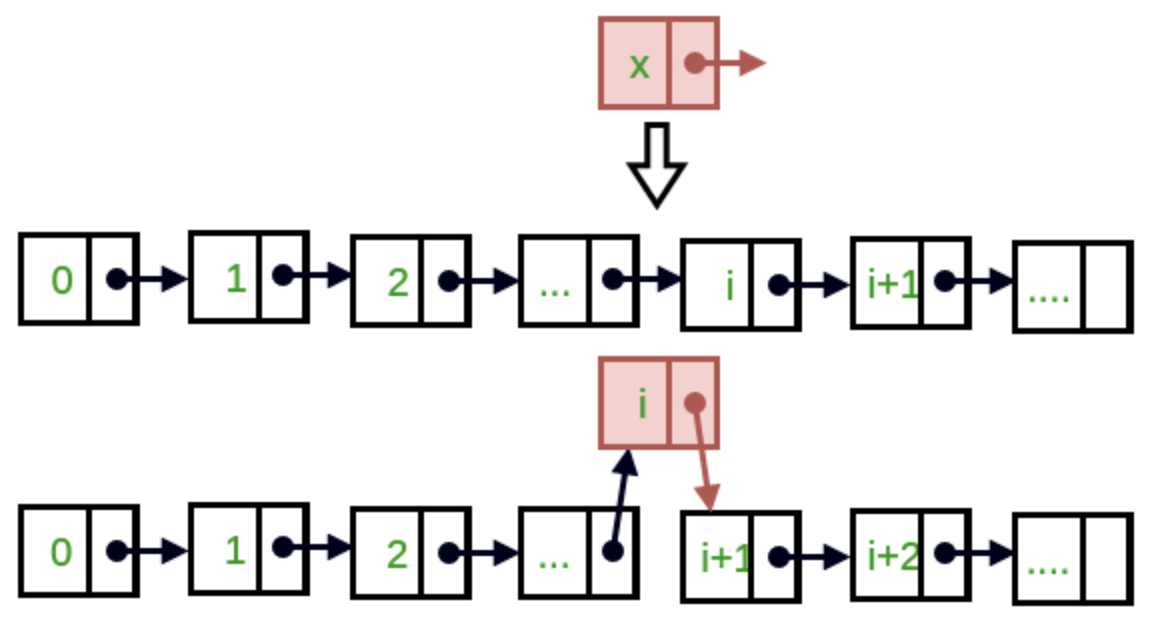数据结构 | 线性表
线性表是一种典型的线性结构。
线性表的顺序实现
顺序表是线性表的顺序存储结构,指的是用一组地址连续的存储单元依次存储线性表的数据元素.
顺序表具备如下两个基本特征:
- 顺序表中的所有元素所占的存储空间是连续的;
- 顺序表中各数据元素在存储空间中是按逻辑顺序依次存放的。
假设顺序表的每个元素需占用$K$个存储单元,并以所占的第一个单元的存储地址作为数据元素的存储位置。则顺序表中第$i+1$个数据元素的存储位置 $LOC(a_{i}+1)$ 和第 $i$ 个数据元素的存储位置 $LOC(a_{i})$ 之间满足下列关系为:
\(LOC(a_{i+1})=LOC(a_i)+K\) \(LOC(a_{i})=LOC(a_{1})+(i-1) * K\)
顺序表的常见操作:
- 插入($O(n)$)
- 删除($O(n)$)
- 查找
- 排序
- 分解
- 合并
- 复制($O(n)$)
- 逆转($O(n)$)
代码:
1
2
3
4
5
6
7
8
9
10
11
12
13
14
15
16
17
18
19
20
21
22
23
24
25
26
27
28
29
30
31
32
33
34
35
36
37
38
39
40
41
42
43
44
45
46
47
48
49
50
51
52
53
54
55
56
57
58
59
60
61
62
63
64
65
66
67
68
69
70
71
72
73
74
75
76
77
78
79
80
81
82
83
84
85
86
87
88
89
90
91
92
93
94
95
96
97
98
99
100
#include <stdio.h>
#include <stdlib.h>
// 实现两个顺序表的归并
typedef struct _List
{
int * elem ;
int length ;
int listsize;
}List , *pList;
void MerginList (pList p1 , pList p2 , pList p3);
void InitList (pList p);
int main ()
{
int i ;
List L1 , L2 , L3;
InitList (&L1);
L1.length = 7;
InitList (&L2);
L2.length = 9;
for (i = 0 ; i < L1.length ; i++)
L1.elem[i] = i*2+1;
for (i = 0 ; i < L2.length ; i++)
L2.elem[i] = i*1+5;
puts ("L1 :");
for (i = 0 ; i < L1.length ; i++)
printf (" %d ",L1.elem[i]);
printf ("\n");
puts ("L2 :");
for (i = 0 ; i < L2.length ; i++)
printf (" %d ",L2.elem[i]);
printf ("\n");
MerginList (&L1 , &L2 , &L3);
puts ("L3 :");
for (i = 0 ; i < L3.length ; i++)
printf (" %d ",L3.elem[i]);
printf ("\n");
return 0;
}
void MerginList (pList p1 , pList p2 , pList p3)
{
int i=0 , j = 0;
int *p ;
int listsize = p1->length + p2->length;
p3->elem = (int *)malloc(listsize*sizeof(int));
p3->length = listsize;
p3->listsize = listsize;
p = p3->elem ;
while (i < p1->length && j < p2->length)
{
if (p1->elem[i] < p2->elem[j])
{
(*p) = p1->elem [i];
i++;
p++;
}
else
{
(*p) = p2->elem[j];
j++;
p++;
}
}
while (i < p1->length)
{
(*p) = p1->elem [i];
i++;
p++;
}
while (j < p2->length)
{
(*p) = p2->elem [j];
j++;
p++;
}
}
void InitList (pList p)
{
p->elem = (int *) malloc (sizeof(int)*10);
p->length = 0;
p->listsize = 10;
}
线性表的链式实现
链表指线性表的链式存储结构。
一组任意的存储单元存储线性表的数据元素,因此,为了表示每个数据元素 $a_i$ 与其直接后继数据元素 $a_{i+1}$ 之间的逻辑关系,对数据元素 $a_i$ 来说,除了存储其本身的信息(数据域)之外,还需存储一个变量指示其直接后继的信息(指针域)。
这两部分信息组成数据元素 $a_{i}$ 的存储映象,称为结点。NN 个结点链结成一个链表。该链表就是传统的单向链表。
有时,我们在单链表的第一个结点之前附设一个结点,称之为头结点,它指向表中第一个结点。头结点的数据域可 以不存储任何信息,也可存储如线性表的长度等类的附加信息,头结点的指针域存储指向第一个结点的指针。在单链表中,取得第 I 个数据元素必须从头指针出发寻找,因此,链表是非随机存取的存储结构。
以上提到的链表指针域只包括一个指针,指向下一个数据的地址,如果我们将链表最后一个结点指针域的指针指向链表的头结点地址,就构成了一个环状的存储结构,我们称作循环链表。
当然我们可以给每个结点的指针域再添加一个指针,使其指向前一个数据结点的地址,这样就构成了双向链表,而将头结点的前一个结点指向尾结点,同时将尾结点的下一个结点指向头结点就构成了双向循环链表。
如果链表的尾结点的指针域指向了该链表之前的任意一个结点,我们称该链表为有环链表。
链表表常见操作:
- 插入($O(n)$)
- 删除($O(n)$)
- 查找
- 排序
- 分解
- 合并
- 复制($O(n)$)
- 逆转($O(n)$)
普通链表
1
2
3
4
5
6
7
8
9
10
11
12
13
14
15
16
17
18
19
20
21
22
23
24
25
26
27
28
29
30
31
32
33
34
35
36
37
38
39
40
41
42
43
44
45
46
47
48
49
50
51
52
53
54
55
56
57
58
59
60
61
62
63
64
65
66
67
68
69
70
71
72
73
74
75
76
77
78
79
80
81
82
83
84
85
86
87
88
89
90
91
92
93
94
95
96
97
98
99
100
101
102
103
104
105
106
107
108
109
110
111
112
113
114
115
116
117
118
119
120
121
122
123
124
#include <stdio.h>
#include <stdlib.h>
#include <time.h>
// 用链表实现排序以及归并问题
typedef struct _Node // 接受链表的指针
{
int data;
struct _Node *next ;
}Node , *pNode;
void addStack (pNode *pl,int a); // 添加新元素
void TraStack (pNode pl); // 遍历栈区
void MerginStack (pNode p1 , pNode p2 , pNode *p3); // 合并栈
int main ()
{
int i , a ;
pNode one = NULL;
pNode two = NULL;
pNode zero;
srand ((unsigned int)time(NULL));
for (i = 0 ; i < 10 ; i++)
{
a = rand() %60;
addStack(&one , a);
}
for (i = 0 ; i < 10 ; i++)
{
a = rand() %60;
addStack(&two , a);
}
TraStack (one);
TraStack (two);
zero = (pNode)malloc(sizeof(Node));
zero->data = 0;
zero->next = NULL;
MerginStack (one,two,zero);
TraStack (zero);
return 0;
}
void addStack (pNode *pl,int a)
{
pNode previous=NULL ; // 用于指向插入点的上一个结点
pNode next ; // 用于指向插入点的下一个结点
pNode New ; // 用于指向插入点的新结点
next = (*pl); // 将next 指向要插入链表的首位置
while (next != NULL && a > next->data)
{
previous=next;
next = next->next;
}
New = (pNode) malloc (sizeof(Node));
New->data = a;
New->next = next;
if (previous == NULL)
(*pl) = New;
else
previous->next = New;
}
void TraStack (pNode pl)
{
while (pl != NULL)
{
printf ("%d -> ",pl->data);
pl = pl->next;
}
printf ("End\n");
}
void MerginStack (pNode p1 , pNode p2 , pNode p3)
// 注意指针本质之间的灵活调用 解决此类问题要站在内存本质的角度上去思考指针问题
{
pNode one = p3 ;
while (p1 != NULL && p2 != NULL)
{
if (p1->data < p2->data)
{
one->next = p1 ;
p1 = p1->next;
p3->data++;
one = one->next;
}
else
{
one->next = p2;
p2 = p2->next;
p3->data++;
one = one->next;
}
}
while (p1!=NULL)
{
one->next = p1 ;
p1 = p1->next;
p3->data++;
one = one->next;
}
while (p2!=NULL)
{
one->next = p2;
p2 = p2->next;
p3->data++;
one = one->next;
}
one=NULL;
}
静态链表 :
用数组描述的链表,即称为静态链表。 在C语言中,静态链表的表现形式即为结构体数组,结构体变量包括数据域data和游标cur。
1
2
3
4
5
6
7
8
9
10
11
12
13
14
15
16
17
18
19
20
21
22
23
24
25
26
27
28
29
30
31
32
33
34
35
36
37
38
39
40
41
42
43
44
45
46
47
48
49
50
51
52
53
54
55
56
57
58
59
60
61
62
63
64
65
66
67
68
69
70
71
72
73
74
75
76
77
78
79
80
81
82
83
84
85
86
87
88
89
90
91
92
93
94
95
96
97
98
99
100
101
102
103
104
105
106
107
108
109
110
111
112
113
114
115
116
117
118
119
120
121
122
123
124
125
#include <stdio.h>
#include <stdlib.h>
#include <time.h>
#define MaxSize 20
typedef struct _SlinkList
{
int data; // 存放数据
int cur ; // 存放游标
}SlinkList , *pSlinkList ;
void InitList (pSlinkList pl); // 初始化静态链表
int MallocSL (pSlinkList pl); // 从备用链表中获取结点
void FreeSL (pSlinkList pl , int i ); // 将指定的结点回收到备用链表
void AddData (pSlinkList pl , int data ,int e); // 将数据添加到指定位置
void TravelSL (pSlinkList pl); // 遍历静态链表区
void Adddata (pSlinkList pl , int data); // 将数据初始化
int main ()
{
int i;
int a;
SlinkList one[MaxSize];
InitList (one); // 初始化静态链表
srand ((unsigned int)time(NULL));
for (i = 0 ; i < 15 ; i++)
{
a = rand()%50;
Adddata (one,a);
}
TravelSL (one);
AddData (one , 12 , 3);
AddData (one , 11 , 1);
TravelSL (one);
return 0;
}
void InitList (pSlinkList pl)
{
int i ;
for (i = 0 ; i < MaxSize-1 ; i++)
pl[i].cur = i+1;
pl[i].cur = 0 ; // 最后一个游标存放第一个有数据的位置
// 如果是 0 则说明没有任何数据
}
int MallocSL (pSlinkList pl)
{
int i = pl[0].cur; // 返回备用链表首结点的位置
if (i == MaxSize-1)
return 0;
pl[0].cur=pl[i].cur; // 重置备用链表首结点
return i;
}
void AddData (pSlinkList pl , int data ,int e)
{
int i ;
int x = MaxSize-1 , y;
int a ;
if (!(a = MallocSL(pl))) // 为新的结点分配内存
{
puts ("error to malloc");
return ;
}
pl[a].data = data;
for (i = 0 ; i < e; i++)
{
y = x; // 指向前一个
x = pl[x].cur ;// 指向下一个
if (y == 0)
{
puts ("error to insert");
return ;
}
}
pl[y].cur = a ;
pl[a].cur = x ; // 链接工作
}
void Adddata (pSlinkList pl , int data)
{
int x = MaxSize-1;
int a = MallocSL (pl);
pl[a].cur = 0;
pl[a].data = data;
if (pl[MaxSize-1].cur==0)
pl[MaxSize-1].cur = a;
else
{
while (pl[x].cur != 0)
x = pl[x].cur;
pl[x].cur = a;
}
}
void TravelSL (pSlinkList pl)
{
int x = MaxSize-1;
while (pl[x].cur != 0)
{
x = pl[x].cur;
printf (" %d ->",pl[x].data);
}
printf (" End\n");
}








